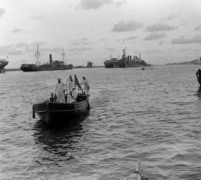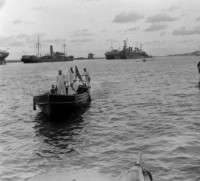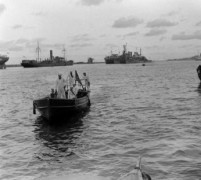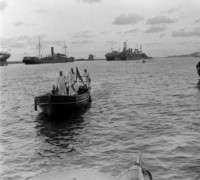U S NAVY 4th FLEET AT RECIFE - SHIP INDEX DE
16)DE 180 TRUMPETER
.jpg)
Photo. www.navsource.org By William H. Roberts, M.D., USNR Trumpeter Commissioning Crew Gunnery, then Executive Officer
Class: CANNON.
Type: DET (diesel-electric tandem motor drive, long hull, 3" guns) .
7 June 1943: Keel laid at the Federal Shipbuilding and Drydock Co., Port Newark, N.J.
19 September 1943: Launched and christened, sponsored by Mrs. Hazel Vivian Trumpeter, mother of Lt. Trumpeter.
16 October 1943: Commissioned, Cdr John R. Litchfteld in command .
14 June 1946: Decommissioned at
Propulsion:
Speed: 21 kts.
Range: 10,800 nm @ 12 knots.Armament: 3 x 3"/50 Mk22 (1x3), 1 twin 40mm Mk1 AA, 8 x 20mm Mk 4 AA, 3 x 21" Mk15 TT (3x1), 1 Hedgehog Projector Mk10 (144 rounds), 8 Mk6 depth charge projectors, 2 Mk9 depth charge tracks.
Complement: 15 / 201.
Late in the morning on the first day of March 1943, Trumpeter arrived at
The escort carrier hunter-killer group was an innovation in antisubmarine warfare which effectively blunted the efficiency of German submarines in the Atlantic shipping lanes. Each group, composed of one escort carrier and its screen of destroyer escorts or old destroyers, aggressively sought out and destroyed enemy submarines in Atlantic waters with notable success. When Trumpeter began patrols in March 1944, however, German submarine activity was not so extensive as it had been earlier in the war, and many of her patrols were uneventful.
In June, while Trumpeter was patrolling in mid
The two DE's picked 23 Germans from the waters, but the flier, whose bold low altitude bombing run had finished off the U-boat, was still missing when the search was ended.Trumpeter's routine of patrol interspersed with periods of repair and upkeep was varied in August with four days of antisubmarine exercises and night battle practice out of Recife.
She departed on 1 September and, on the 3d, joined
On 4 October, she anchored in Gibraltar Bay but, less than six hours later, was again underway for the east coast. Arriving at
In December, she engaged in gunnery practice and, later in the month, made routine patrols out of



